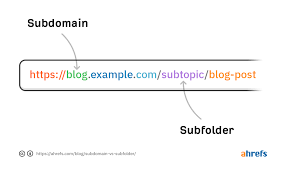
Table of Contents
What is Subdomain?
A subdomain is an extension to your main domain name. Subdomains are used to organize and navigate your website’s various sections. On your main domain, you can have multiple subdomains or child domains.
As an example:
store.yourwebsite.com
In this example, the subdomain is’store,’ the primary domain is ‘yourwebsite,’ and the top level domain is ‘.com’ (TLD). You can use any text as your subdomain, but it should be easy to type and remember.
Subdomains are used by businesses for a variety of reasons. Let’s take a look at some of the most common subdomain use cases.
Subdomain Use Cases
A subdomain is most commonly used to create a testing or staging version of a website. Developers frequently test new plugins and updates on a subdomain staging site before releasing them to the public.
A subdomain is also commonly used to create an online eCommerce store. Because eCommerce sites typically necessitate a more complex setup, businesses frequently request a separate subdomain to handle transactions.
We’ve also seen businesses use subdomains for mobile websites (m.yoursite.com), location-specific sites (uk.yoursite.com), and website sub-sections.
You can install WordPress on your subdomain, and it will function independently of your main website.
Subdomains such as ‘guest.yourwebsite.com,’ ‘user.yourwebsite.com,’ and others can be used to serve a specific group of users on your site. This is how website builder platforms such as WordPress.com, Blogger.com, and others provide users with custom websites.
Subdomains can help you organize your website’s content more effectively. The proper use of a subdomain does not affect the SEO of your main website. When in doubt, however, we recommend keeping everything on the same domain and avoiding the use of a subdomain for public sites.
How to Set Up a Subdomain?
A subdomain can be easily created in your domain registrar or WordPress hosting account. In this example, we’ll use our hosting provider Bluehost to create a subdomain, but the process is the same across all platforms.
To create a subdomain with Bluehost, you must first log into your web hosting account. Then, on the left, select the “Domains” tab. This will bring up a submenu with some options.
Now, on the list, select the “Subdomains” tab.
Your domain name is in the field on the right. If you only have one domain on your web hosting account, you will not need to make any changes. If you have multiple domains, they will all be listed in the drop-down menu. In our example, there is only one domain, “yourdomain.org.”
Next, in the field on the right, enter a name for your new subdomain. You can enter anything you want, such as a blog, gallery, or store. We’ll use “demo” in this example.
After you’ve entered a name for your subdomain, press the “Create” button.
Your new subdomain will appear at the bottom of the screen right away. Your subdomain address will now be displayed at the beginning of your domain name. In our case, it went from “yourdomain.com” to “demo.yourdomain.com.” Notice how your new subdomain automatically populates the home folder field for your subdomain.
Congratulations! You have just set up your first subdomain.
Subdomains vs. Subdirectories: Which is Better for SEO?
Subdomains and subdirectories are viewed differently by search engines. Let’s take a look at why this is true and how using a subdomain versus a subdirectory affects SEO.
Google and other search engines treat subdomains as if they were separate websites. Search engines must crawl and index each subdomain separately as a result.
It is critical to remember that the “link juice” generated by backlinks to your main site is not shared by your domain and subdomains. Building page rank for keywords in a subdomain is just as difficult as it is in a separate website.
Subdomains should be used only when necessary. Subdomains, for example, can be used to rank for different keywords, target a specific market, reach a different location, or serve a language other than the one used by your main website.
Subdirectories are folders that contain files from your primary domain. Subdirectories are not treated as separate sites by Google or other search engines, so “link juice” and SEO are shared between your domain and subdirectories.
For bloggers, startups, or small businesses with limited time and resources, using subdirectories rather than a subdomain will help you rank your website faster.

